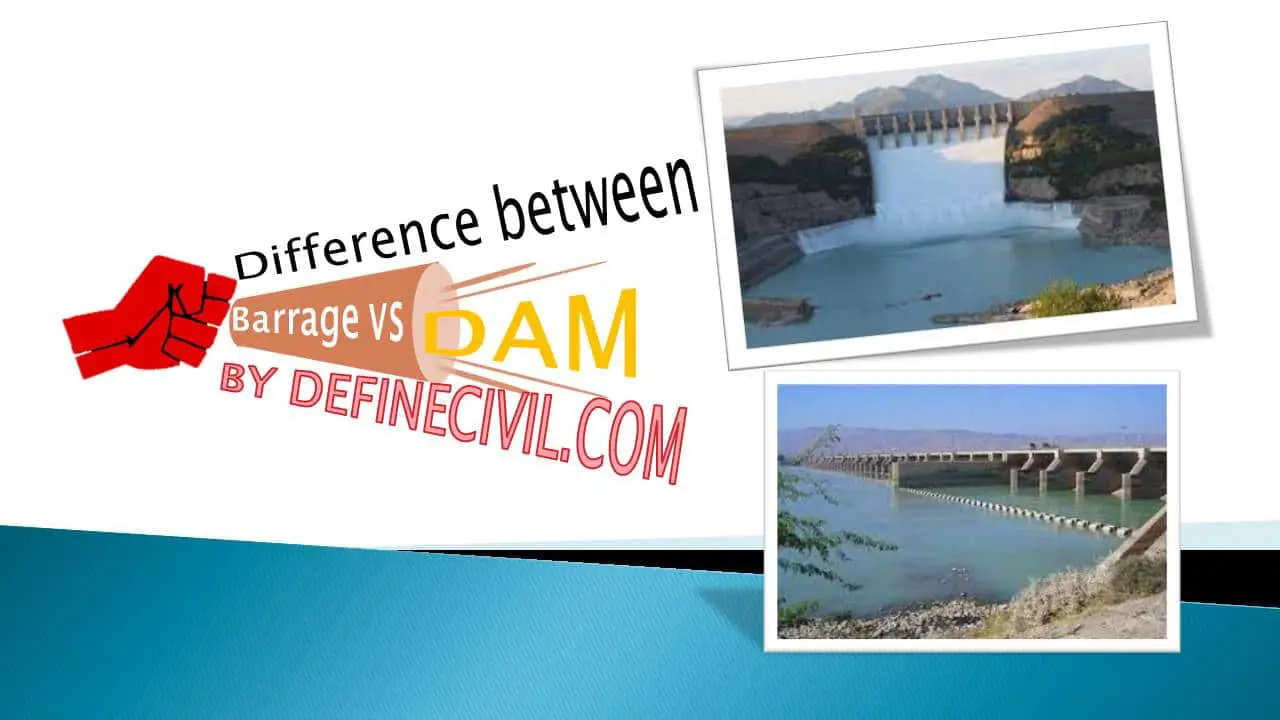Yes! figuring difference between a dam and barrage can be difficult for newbies. To your help, we’ve made this simple guide to share some fun facts and differences.
Well, dam and Barrage are two of the most common structures built across bank of river. They help control floods and both look similar in appearance. But there is a considerable difference in their structure and function.
Though civil engineers construct dam across a river to prevent flooding. But besides it also perform other functions like power generation and water storage.
In contrast, a barrage is an old style of construction that is merely for flood control.
But that’s not all.
There’s still more depth in the concept.
So, here’s our take on the difference between a dam and a barrage.

What is a dam?
Diversion headworks or dam is a significant type of flood control structure. We construct it across the river, with a spillway from the ground to the top for diverting water.
So, a dam has a large lake-like reservoir at the upstream. The spillway of a dam allows natural water flow of over twenty thousand gallons per minute.
A dam is a multi-purpose structure. So, people or community can get a lot of benefits from its construction.
We use them for purposes like:
- Storage of water
- Irrigation purpose
- Hydroelectric power
- Flood control

What is Barrage?
Weir is an impenetrable structure. It is an obstruction we build across the stream across the river width. It helps raise water level at the upstream to check the flood, store water or measure discharge.
The simplest definition of a barrage be like – a gated weir is a barrage.
With that we can say, a barrage is an artificial obstruction that we construct across the river’s flow. It helps regulate the river’s flow.
It can divert the river water into the canal after raising the water to a for the irrigation of the catchment area.
Difference between barrage and dam
The dam, in contrast, is a waterproof obstruction meant to store water, generate electricity and control floods.
Differences in function
The dam’s primary function is to create a water reservoir. Community uses this storage for drinking purpose. Beside, we can also generate electricity with the help of the energy stored in the water as a head.
So, dams are multi-purpose. The functions for water storage, electricity or power generation, aesthetic or artistic purpose.
But, the barrage has no such storage of water; So, you can’t say it as head raising headworks. The primary function of barrage is to regulate the flow of the river of water only.
It helps send calculated amount of water into the canals for agriculture use.
The word “barrage” is a French word having the meaning of “a dam”. Two french scientists used this word while working in Egyptian Public works.
It was the time when Delta Barrage across Nile-Branches near north of Cairo was built.
Anyhow, british use the word barrage to call similar structures constructed in British India. That is why the word “barrage” is still used for structures built in the Middle East, Iran, Pakistan and India.

Barrage vs Dam
As we know, designers provide gates and sluices both in barrages and dams, so what’s the difference?
The answer is simple.
In dams, the gates and channels are always at the top. These orifices or spillways help by-pass flooding without damaging the dam body.
This helps keep enough amount of water for later use.
When the need arise, the water can pass through gates in the system called spillway.
In contrast for barrages, the gates are from the top up to the bed of the river.
With such, the barrage’s water storage capacity depends on the height of gates.
[su_table responsive=”yes”]
| Sr. No. | Difference | Dam | Barrage |
| 1 | Storage at upstream side | Must have | Not have storage |
| 2 | Gates | at the top of the intake structure | at the entire height of the structure. |
| 3. | Purpose | Flood control, hydropower, irrigation, water supply, recreation | Just to divert river water |
| 4. | Popularity | Use throughout the world | Mostly constructed in East, Iran, Pakistan and India. |
[/su_table]
Key takeaways!
Constructing both dam and barrage, helps for efficient water use. Both help pass the runoff from large river into smaller streams.
This help raise the groundwater water table.
But, a dam or barrage would influence the amount of water sent to the underground water. The impact on wildlife and aquatic habitats would be massive.
The three gorges dam had a considerable impact after construction. It resulted in the loss of agricultural land and altering the water supply system.
But, a diversion dam or other type of control would allow us to divert water without a trouble.

















